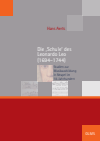Zusammenfassung
Von jeher gilt Leonardo Leo (1694–1744) nicht nur als wichtiger Komponist, sondern auch als bedeutender Kompositionslehrer. Zeitweilig, so die Überlieferung, sei die neapolitanische Musiklandschaft von einem Gegensatz zweier Systeme oder Schulen geprägt gewesen, mit Anhängern Leos auf der einen und Francesco Durantes (1684–1755) auf der anderen Seite. Vor allem im Zuge der Partimento-Forschung hat sich die jüngere Musikforschung dieser Musiklandschaft, ihren Institutionen und Hauptfiguren wieder verstärkt zugewandt. Geblieben ist dabei eine mythologisierende und verklärende Patina, die Leos Bild und das seines Umfelds im Laufe der Zeit überdeckt hat. Diese Schichten sucht Hans Aerts anhand institutionsgeschichtlicher, biografischer, quellenkritischer, musiktheoretischer und musikanalytischer Studien abzutragen. Er rekonstruiert den Rahmen, in dem Musiker in der ersten Hälfte des 18. Jahrhunderts in Neapel ausgebildet wurden, beleuchtet Leos Laufbahn und seinen Schülerkreis, untersucht die Hintergründe der Überlieferungen zum Gegensatz zwischen Leisti und Durantisti und erforscht die Quellen, die mit Leos Unterrichtspraxis in Verbindung gebracht worden sind. Ein besonderer Schwerpunkt ist dabei die Analyse eines Korpus von 50 Solfeggi. Häufig schwingt bei diesen Untersuchungen auch die Frage mit, welche Perspektiven sich daraus für die heutige musiktheoretische Lehrpraxis ergeben.
Abstract
Leonardo Leo (1694–1744) has always been regarded not only as an important composer, but also as an important teacher of composition. According to tradition, the Neapolitan musical landscape was at times characterised by the opposition of two systems or schools, with followers of Leo on the one side and Francesco Durante (1684-1755) on the other. In the course of research on the partimento in particular, more recent music research has turned its attention to this musical landscape, its institutions and main figures. What has remained is a mythologising and transfiguring patina that has covered Leo's image and that of his environment over time. Hans Aerts seeks to remove these layers by means of studies in institutional history, biography, source criticism, music theory and music analysis. He reconstructs the framework in which musicians were educated in Naples in the first half of the 18th century, sheds light on Leo's career and his circle of pupils, examines the background of the traditions on the opposition between Leisti and Durantisti and explores the sources that have been associated with Leo's teaching practice. A particular focus is the analysis of a corpus of 50 solfeggi. Frequently, these investigations also raise the question of what perspectives they offer for today's music-theoretical teaching practice.
Schlagworte
18. Jahrhundert 18th century composer Francesco Durante composition teacher Gegensatz contrast Italien Italy Komponist Kompositionslehrer music Leonardo Leo music analysis music education studies Musik music research Musikanalyse music theory Musiker musician Musikforschung Musiktheorie Naples Neapel partimento research Partimento-Forschung Studien zur Musikausbildung- Kapitel Ausklappen | EinklappenSeiten
- 11–18 Einleitung 11–18
- 19–136 1 Kontext 19–136
- 137–228 2 Quellen 137–228
- 229–392 3 Analysen 229–392
- 393–400 Fazit und Ausblick 393–400
- 413–486 Anhänge 413–486

